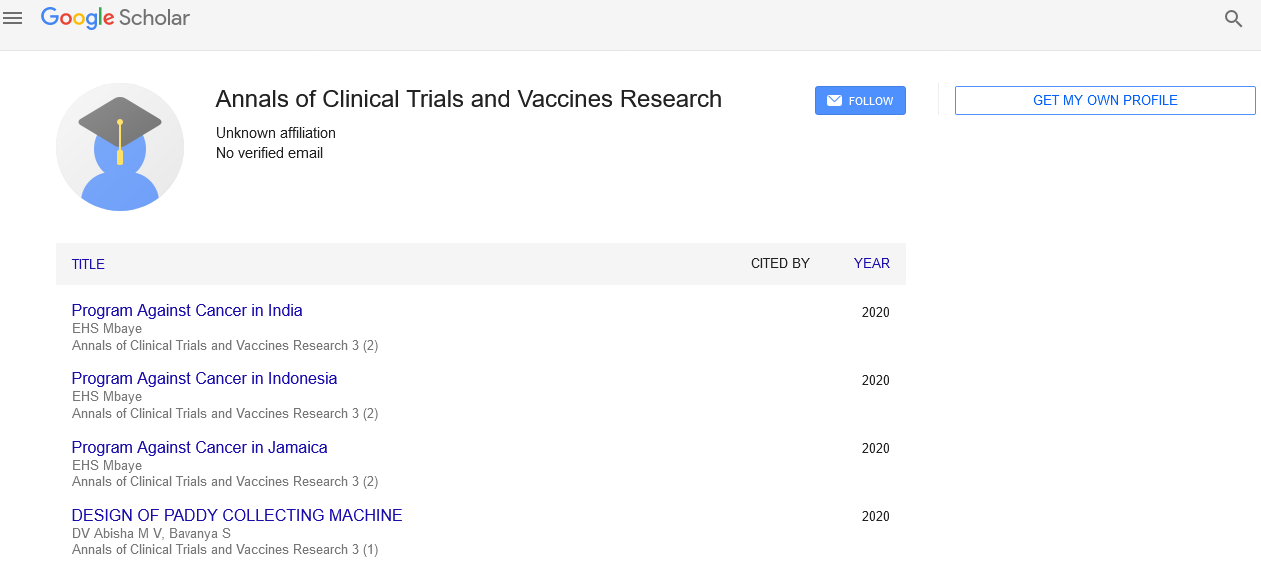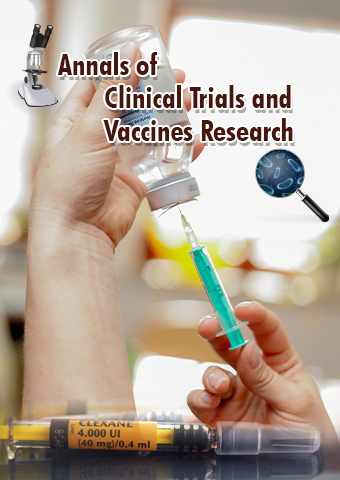Commentary - Annals of Clinical Trials and Vaccines Research (2023) Volume 13, Issue 4
Evaluating the Efficacy and Safety of Novel Therapeutic in Phase 3 Clinical Trial
Angelica Merlot*
Department of Pathology, University of Sydney, Australia
Department of Pathology, University of Sydney, Australia
E-mail: angelica.merlot@gmail.com
Received: 01-August-2023, Manuscript No. actvr-23-108540; Editor assigned: 3-August-2023, PreQC No. actvr-23-108540 (PQ); Reviewed: 17-August-2023, QC No. actvr-23-108540; Revised: 22-August-2023, Manuscript No. actvr-23-108540 (R); Published: 28-August-2023; DOI: 10.37532/ ACTVR.2023.13(4).125-127
Abstract
Phase 3 clinical trials are a critical and pivotal stage in the drug development process, aimed at evaluating the safety and efficacy of a new medical intervention in a large and diverse patient population. These trials follow the successful completion of Phase 1 and Phase 2 studies, which assessed the investigational product’s safety profile, dosage range, and initial efficacy. Phase 3 trials are designed to provide substantial evidence to support the regulatory approval of the new drug or medical intervention and are considered the last step before potential market release.
Introduction
At the outset of Phase 3, researchers have accumulated promising data from earlier stages, which has led to the selection of a specific dose, formulation, and administration route for further investigation. These trials are randomized and controlled, meaning that patients are assigned randomly to receive either the investigational intervention or a control group that may receive a placebo or the standard of care.
The patient population involved in Phase 3 trials is considerably larger and more diverse than in earlier phases, often involving thousands of participants. This is necessary to gain a better understanding of how the intervention performs across different demographics and to detect potential rare or long-term side effects that might not have surfaced in earlier, smaller cohorts.
The primary goal of Phase 3 clinical trials is to assess the intervention’s efficacy, meaning whether it delivers the intended therapeutic effect as anticipated. Researchers also pay close attention to safety, looking for any adverse reactions or side effects that could outweigh the benefits of the treatment. To achieve these objectives, Phase 3 trials employ robust methodologies, such as double-blinding, where neither the participants nor the investigators know which group is receiving the actual intervention or the control. This ensures the results are not influenced by bias or preconceived notions [1-3].
The duration of Phase 3 trials varies, but they typically last for several years. During this time, researchers meticulously collect data on the participants’ health outcomes, often utilizing various assessment tools, diagnostic tests, and patient-reported outcomes. Regular monitoring and follow-up are essential to track any changes in health status and ensure the accuracy of the findings.
Apart from evaluating efficacy and safety, Phase 3 trials also explore secondary endpoints. These may include further investigations into the intervention’s impact on specific subsets of the population, comparisons with other existing treatments, and analyses of potential benefits on additional symptoms or complications. These secondary endpoints offer a more comprehensive picture of the intervention’s overall impact on the disease or condition being studied [4,5].
Discussion
Throughout the trial, an independent Data and Safety Monitoring Board (DSMB) regularly reviews the accumulating data to guarantee participant safety and scientific integrity. If the intervention exhibits remarkable efficacy or safety concerns, the DSMB may recommend modifying or discontinuing the trial early to protect the participants or allow early access to the treatment if it proves beneficial. Once the data collection phase concludes, researchers undertake a rigorous analysis to interpret the results. Statistical methods are employed to determine whether the intervention’s efficacy is significant compared to the control group and to quantify the magnitude of the effect. The statistical significance helps establish confidence in the findings and supports the potential approval of the intervention by regulatory agencies, such as the Food and Drug Administration (FDA) in the United States or the European Medicines Agency (EMA) in Europe.
If the results of Phase 3 trials are positive and demonstrate that the intervention is both effective and safe, the data is submitted to the relevant regulatory authority as part of a New Drug Application (NDA) or a Biologics License Application (BLA) for biological products. The regulatory agency reviews the data thoroughly to determine whether the benefits of the intervention outweigh its risks and whether it meets the necessary standards for approval. Successfully completing Phase 3 trials and receiving regulatory approval marks a significant milestone in the drug development journey. It signifies that the intervention has met the highest scientific and safety standards and can now be marketed and made available to patients in need. It’s important to acknowledge that not all Phase 3 trials achieve their primary endpoints or receive regulatory approval. In such cases, researchers and sponsors may need to reevaluate the intervention, analyze the trial’s shortcomings, and consider further development or alternative approaches [6-8].
Phase 3 clinical trials play a pivotal role in the drug development process, providing crucial evidence on the safety and efficacy of new medical interventions in diverse patient populations. These trials are conducted with scientific rigor, employing randomized and controlled methodologies to ensure accurate and unbiased results. Successful completion of Phase 3 trials and subsequent regulatory approval pave the way for new treatments to reach patients, offering hope and potential solutions for various medical conditions and improving global public health. A Phase 3 clinical trial is a crucial and rigorous stage in the drug development process, representing the final step before seeking approval from regulatory authorities to bring a new treatment to the market. This phase aims to evaluate the safety, efficacy, and potential benefits of the investigational drug or intervention in a larger and more diverse population, following the promising results obtained in Phase 1 and Phase 2 trials [9,10].
Conclusion
In conclusion, Phase 3 clinical trials play a pivotal role in the drug development process, providing crucial evidence on the safety and efficacy of new medical interventions in diverse patient populations. These trials are conducted with scientific rigor, employing randomized and controlled methodologies to ensure accurate and unbiased results. Successful completion of Phase 3 trials and subsequent regulatory approval pave the way for new treatments to reach patients, offering hope and potential solutions for various medical conditions and improving global public health
Phase 3 trials are meticulously designed, carefully controlled, and often involve thousands of participants across multiple research centers, enhancing the statistical power and generalizability of the findings. These trials typically employ a randomized, double-blind, and placebo-controlled design, ensuring impartiality and reducing the risk of bias. Randomization divides participants into different groups, with some receiving the experimental treatment and others receiving either a placebo or the current standard of care.
References
- Reynolds A, Mann J, Cummings J et al. Carbohydrate quality and human health, a series of systematic reviews and meta-analyses. Lancet. 393, 434-445 (2019).
- Mannucci E, Giaccari A, Gallo M et al. Self-management in patients with type 2 diabetes, Group-based versus individual education a systematic review with meta-analysis of randomized trails. Nutr Metab Cardiovasc Dis. 32, 330-336(2022).
- O'Gorman DJ, Krook A. Exercise and the treatment of diabetes and obesity. Med Clin N. 95, 953-969 (2011).
- Koutroumpakis E, Jozwik B, Aguilar D et al. (2020) Strategies of Unloading the Failing Heart from Metabolic Stress. Am J Med. 133, 290-296.
- Gregg EW, Li Y, Wang J et al. Changes in diabetes-related complications in the United States, 1990-2010. N Engl J Med. 370, 1514-1523(2011).
- Sun J, Buys NJ. Glucose- and glycaemic factor-lowering effects of probiotics on diabetes, a meta-analysis of randomised placebo-controlled trials. British Journal of Nutrition. 115, 1167-1177 (2016).
- Phramor, Lucy. Validity of claims made in weight management research, a narrative review of dietetic articles. Nutrition Journal. 9, 30 (2010).
- Long Zichong, Huang Lili, Lyu Jiajun et al. Trends of central obesity and associations with nutrients intake and daily behaviors among women of childbearing age in China. BMC Women's Health. 22, 12 (2022)
- Beccuti G, Monagheddu C, Evangelista A et al. Timing of food intake, Sounding the alarm about metabolic impairments? A systematic review. Pharmacological Research. 125, 132–141 (2017).
- Anderson JW, Ward K High-carbohydrate, high-fiber diets for insulin-treated men with diabetes mellitus. Am J Clin Nutr. 32, 2312-2321 (1979).
Indexed at, Google Scholar, Crossref
Indexed at, Google Scholar, Crossref
Indexed at, Google Scholar, Crossref
Indexed at, Google Scholar, Crossref
Indexed at, Google Scholar, Crossref
Indexed at, Google Scholar, Crossref

